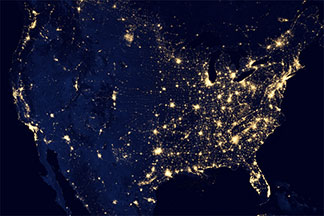Reduce: reduce energy use and reduce bird injuries or death
Featured image: Photo: NASA Earth Observatory – insight on human activity at night
Providing Safe Passage for Nocturnal Migrants
Every year, billions of birds migrate north in the spring and south in the fall, the majority of them flying at night, navigating with the night sky. However, as they pass over big cities on their way, they can become disoriented by bright artificial lights and skyglow, often causing them to collide with buildings or windows.
While lights can throw birds off their migration paths, bird fatalities are more directly caused by the amount of energy the birds waste flying around and calling out in confusion. The exhaustion can then leave them vulnerable to other urban threats.
Dozens of species are affected, including priority species—those we have identified as most in need of and most likely to benefit from our help— such as the Allen’s Hummingbird, Wood Thrush, and Golden-winged Warbler. Just one building can cause major problems for birds in the area; within one week in 2017, nearly 400 passerines (warblers, grosbeaks, etc.) were caught in the floodlights of a 32-story Texas skyscraper and killed via window collisions.
https://www.audubon.org/lights-out-program
Audubon’s Lights Out program is a national effort to reduce this problem.
The strategy is simple: by convincing building owners and managers to turn off excess lighting during the months migrating birds are flying overhead, we help to provide them safe passage between their nesting and wintering grounds.
Contribute to Lights Out
- Turn off exterior decorative lighting
- Extinguish pot and flood-lights
- Substitute strobe lighting wherever possible
- Reduce atrium lighting wherever possible
- Turn off interior lighting especially on higher stories
- Substitute task and area lighting for workers staying late or pull window coverings
- Down-shield exterior lighting to eliminate horizontal glare and all light directed upward
- Install automatic motion sensors and controls wherever possible
- When converting to new lighting assess quality and quantity of light needed, avoiding over-lighting with newer, brighter technology
- Note from Taylor: If you are in a new neighborhood, replacing existing light poles, or replacing light pole lights, work with your utility provider to make sure the wattage is low but effective. The newest and brightest CFL just blinds everyone and interferes with sleep cycles, as well as bird safety. One of the sections in my neighborhood had newer, whiter, brighter bulbs put in the new light poles and everyone complained so much the city had to replace all those new bulbs with the lower more yellow wattage. Get feedback from the community.
In Austin, Texas, Travis Audubon and a coalition of other local and state organizations want us to flip the switch for birds this spring! Nearly two billion birds migrate across Central Texas skies each spring and fall, and many of them fly at night. Spring migration is already underway and we want to make their journey as safe as possible. Artificial lighting can cause birds to be disoriented and collide with buildings, and these avoidable collisions kill up to one billion migratory birds annually in the United States.
The good news is that everyone can help. Let’s turn off all nonessential indoor and outdoor lighting from 11 p.m. to 6 a.m. March 1 – June 15, but especially during peak migration dates of April 22 – May 12. Please shut off porch, string and garage lights, close your curtains and shades, and ask your office building management to shut off their lights at night, too. You’ll be protecting birds while also saving money on energy. Learn more at https://travisaudubon.org/lights-out-texas or find your local chapter’s information as well as more specific migration patterns for your area at https://www.audubon.org/lights-out-program.
Text featured here is a combination of the national Audubon and Travis Audubon Lights Out programs.
#lightsout #savebirds #migration #saveenergy #lightpollution
